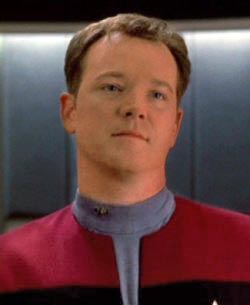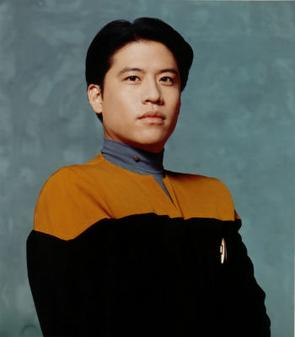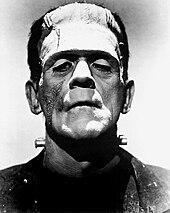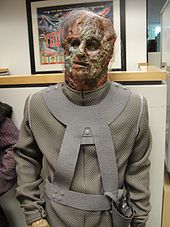
Chakotay is a fictional character who appears in each of the seven seasons of the American science fiction television series Star Trek: Voyager. Portrayed by Robert Beltran, he was First Officer aboard the Starfleet starship USS Voyager, and later promoted to Captain in command of the USS Protostar in Star Trek: Prodigy. The character was suggested at an early stage of the development of the series. He is the first Native American main character in the Star Trek franchise. This was a deliberate move by the producers of the series, who sought to provide an inspiration as with Uhura in Star Trek: The Original Series for African Americans. To develop the character, the producers sought the assistance of Jamake Highwater who falsely claimed to be Native American. Despite first being named by producers as a Sioux, and later a Hopi, Chakotay was given no tribal affiliation at the start of the series, and eventually was assigned ancestry with a fictional tribe in the episode "Tattoo”. It wasn’t until his appearance in Star Trek: Prodigy that he was formally identified as a descendant of the Nicarao people of Central America.

Kes is a fictional character played by Jennifer Lien on the American science fiction television show Star Trek: Voyager. The series follows the crew of the starship USS Voyager, stranded far from home and struggling to get back to Earth. Kes joins the crew in the pilot episode "Caretaker", opening an aeroponics garden and working as the medical assistant to the artificial intelligence known as the Doctor. She is a member of a telepathic alien species known as the Ocampa who have latent psychic abilities and a life span of only nine years. Her storylines focus on encouraging the Doctor to develop his humanity and dealing with her Talaxian boyfriend Neelix's jealousy. She also seeks to expand upon her mental capabilities, leaving in the fourth season after her powers threaten to destroy the ship. She reappears in a season six episode and features in Star Trek: Voyager novels and short stories.

Lieutenant Thomas Eugene "Tom" Paris is a fictional character in the American science fiction television series Star Trek: Voyager and is portrayed by Robert Duncan McNeill. Paris is the chief helmsman, as well as a temporary auxiliary medic, of the USS Voyager, a Starfleet ship that was stranded in the Delta Quadrant by an alien entity known as the Caretaker.
Star Trek: Voyager is an American science fiction series created by Rick Berman, Michael Piller and Jeri Taylor. It aired from January 16, 1995, to May 23, 2001, on UPN, with 172 episodes over seven seasons. The fifth series in the Star Trek franchise, it served as the fourth after Star Trek: The Original Series. Set in the 24th century, when Earth is part of a United Federation of Planets, it follows the adventures of the Starfleet vessel USS Voyager as it attempts to return home to the Alpha Quadrant after being stranded in the Delta Quadrant on the far side of the galaxy.

The Kazon are a fictional alien race in the Star Trek franchise. Developed by Star Trek: Voyager series' co-creators Rick Berman, Michael Piller, and Jeri Taylor, the Kazon serve as the primary antagonists during the show's first two seasons. They are represented as a nomadic species divided into eighteen separate sects, and characterized by their reliance on violence. A patriarchal society, the Kazon have a low opinion of women, and place pride in men becoming warriors and proving themselves in battle. The Kazon storylines frequently revolve around the attempts of Jal Culluh and his Kazon sect to steal technology from the USS Voyager, with the assistance of former Voyager ensign Seska. During the second season, the Voyager crew uncover more about the alien species' history and culture through a temporary truce. In their final major appearance, the Kazon successfully commandeer Voyager, but are eventually forced to surrender and retreat. The alien species have minor cameo appearances and references in the show's subsequent seasons, and have also been included in Star Trek Online and novels set in the Star Trek universe.
"Investigations" is the 36th episode of the American science fiction television series Star Trek: Voyager which aired on the UPN network. It is the 20th episode of the second season.
"Deadlock" is the 37th episode of Star Trek: Voyager, the 21st episode of the second season. In this television show, part of the Star Trek franchise, a Federation ship is stranded on the opposite side of the Galaxy as Earth in the late 2300s. On its way home the starship encounters many species of aliens and outer space phenomenon. In this episode their ship is split into two versions of itself sharing the same power source, while being attacked by a species of organ harvesting aliens known as the Vidiian.
"State of Flux" is the eleventh episode of Star Trek: Voyager, which was a science fiction television show that ran from 1995-2001. Recurring Voyager characters Seska and Lt. Carey star, along with the show's main cast, in an episode that sees the return of the Kazon aliens previously introduced in "Caretaker".
"Phage" is the fifth episode of the first season of the American science fiction television series Star Trek: Voyager. The episode was directed by Winrich Kolbe. Set in the 24th century, the series follows the adventures of the Starfleet and Maquis crew of the starship USS Voyager after they are stranded in the Delta Quadrant far from the rest of the Federation.
"Cathexis" is the thirteenth episode of Star Trek: Voyager, a science fiction television show that ran from 1995–2001. Part of the Star Trek franchise, it features a starship from the United Federation of Planets stranded on the other side of the Galaxy that must make its way home as it encounters aliens and various phenomena. On board a mixture of Federation, Maquis, and alien crew members live and work.
"Faces" is an episode of the American science fiction television series Star Trek: Voyager. Set in the 24th century, the series follows the adventures of the Starfleet and Maquis crew of the starship USS Voyager after they are stranded in the Delta Quadrant, far from the rest of the Federation. The fourteenth episode of the first season, first broadcast by UPN on May 8, 1995. "Faces", was developed from a story by Jonathan Glassner and Kenneth Biller, Biller also wrote the teleplay, which was directed by Winrich Kolbe.

"Basics" comprises the 42nd and 43rd episodes of the science fiction television Star Trek: Voyager, the cliffhanger between the second season and the third season.
"Shattered" is the 157th episode of the American science fiction television series Star Trek: Voyager, aired on the UPN network. It is the 10th episode of the seventh season.
"Projections" is the 19th episode of the American science fiction television program Star Trek: Voyager. Originally slated for the first season, the episode originally aired on UPN on September 11, 1995, and tells the story of the ship's holographic doctor suffering an identity crisis on the holodeck regarding whether he or the world around him is the illusion.
"Workforce" is a two-part episode from the seventh and final season of the TV series Star Trek: Voyager. Part one was directed by Allan Kroeker, and part two by Roxann Dawson. The crew of the USS Voyager finds themselves working on a planet, but troubling memories are resurfacing.
"Maneuvers" is the 27th episode of Star Trek: Voyager, and the 11th episode in the second season. This episode continues the narrative of the U.S.S. Voyager and their struggle against the hostile Kazon, with a specific focus on Voyager's First Officer Chakotay. It also features several special effect sequences with various spacecraft.
"Lifesigns" is the 35th episode of Star Trek: Voyager, the 19th episode of the second season. It has an average fan rating of 4.2/5 on the official Star Trek website as of September, 2009.
"Resolutions" is the 41st episode of the science fiction television program Star Trek: Voyager. The episode originally aired on May 13, 1996. The series follows the adventures of the Federation starship Voyager during its journey home to Earth, having been stranded tens of thousands of light-years away. This episode focuses on the relationship between Captain Janeway and First Officer Chakotay, who have been left on a planet after contracting a virus, and the rest of the crew search for a cure under Tuvok's command.

Ensign Harry S. L. Kim is a fictional character who appeared in each of the seven seasons of the American television series Star Trek: Voyager. Portrayed by Garrett Wang, he is the Operations Officer aboard the Starfleet starship USS Voyager.









